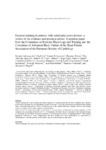Mostrar o rexistro simple do ítem
Exercise training in patients with ventricular assist devices: a review of the evidence and practical advice. A position paper from the Committee on Exercise Physiology and Training and the Committee of Advanced Heart Failure of the Heart Failure Association of the European Society of Cardiology
| dc.contributor.author | Adamapoulos, Stamatis | |
| dc.contributor.author | Corrá, Ugo | |
| dc.contributor.author | Laoutaris, Ioannis D. | |
| dc.contributor.author | Pistono, Massimo | |
| dc.contributor.author | Agostoni, Piergiuseppe | |
| dc.contributor.author | Coats, Andrew J.S. | |
| dc.contributor.author | Crespo-Leiro, María Generosa | |
| dc.contributor.author | Cornelis, Justien | |
| dc.contributor.author | Davos, Constantinos H. | |
| dc.contributor.author | Filippatos, Gerasimos | |
| dc.contributor.author | Lund, Lars H. | |
| dc.contributor.author | Jaarsma, Tiny | |
| dc.contributor.author | Ruschitzka, Frank | |
| dc.contributor.author | Seferovic, Petar M. | |
| dc.contributor.author | Schmid, Jean-Paul | |
| dc.contributor.author | Volterrani, Maurizio | |
| dc.contributor.author | Piepoli, Massimo F. | |
| dc.date.accessioned | 2019-01-29T09:51:48Z | |
| dc.date.issued | 2018-11-26 | |
| dc.identifier.citation | Adamopoulos S, Corrá U, Laoutaris ID, et al. Exercise training in patients with ventricular assist devices: a review of the evidence and practical advice. A position paper from the Committee on Exercise Physiology and Training and the Committee of Advanced Heart Failure of the Heart Failure Association of the European Society of Cardiology. Eur J Heart Fail. 2019; 21(3): 3-13 | es_ES |
| dc.identifier.issn | 1388-9842 | |
| dc.identifier.uri | http://hdl.handle.net/2183/21625 | |
| dc.description.abstract | [Abstract] Exercise training (ET) and secondary prevention measures in cardiovascular disease aim to stimulate early physical activity and to facilitate recovery and improve health behaviours. ET has also been proposed for heart failure patients with a ventricular assist device (VAD), to help recovery in the patient's functional capacity. However, the existing evidence in support of ET in these patients remains limited. After a review of current knowledge on the causes of the persistence of limitation in exercise capacity in VAD recipients, and concerning the benefit of ET in VAD patients, the Heart Failure Association of the European Society of Cardiology has developed the present document to provide practical advice on implementing ET. This includes appropriate screening to avoid complications and then starting with early mobilisation, ET prescription is individualised to meet the patient's needs. Finally, gaps in our knowledge are discussed. | es_ES |
| dc.language.iso | eng | es_ES |
| dc.publisher | Wiley | es_ES |
| dc.relation.uri | https://doi.org/10.1002/ejhf.1352 | es_ES |
| dc.rights | This is the peer reviewed version of the article which has been published in final form at Wiley Online Library. This article may be used for non-commercial purposes in accordance with Wiley Terms and Conditions for self-archiving. | es_ES |
| dc.subject | Exercise training | es_ES |
| dc.subject | Left ventricular assist device | es_ES |
| dc.subject | Mechanical circulatory support | es_ES |
| dc.subject | Chronic heart failure | es_ES |
| dc.title | Exercise training in patients with ventricular assist devices: a review of the evidence and practical advice. A position paper from the Committee on Exercise Physiology and Training and the Committee of Advanced Heart Failure of the Heart Failure Association of the European Society of Cardiology | es_ES |
| dc.type | info:eu-repo/semantics/article | es_ES |
| dc.rights.access | info:eu-repo/semantics/embargoedAccess | es_ES |
| dc.date.embargoEndDate | 2019-11-26 | es_ES |
| dc.date.embargoLift | 2019-11-26 | |
| UDC.journalTitle | European Journal of Heart Failure | es_ES |
| UDC.volume | 21 | es_ES |
| UDC.issue | 3 | es_ES |
| UDC.startPage | 3 | es_ES |
| UDC.endPage | 13 | es_ES |
Ficheiros no ítem
Este ítem aparece na(s) seguinte(s) colección(s)
-
INIBIC-ICATC - Artigos [177]






